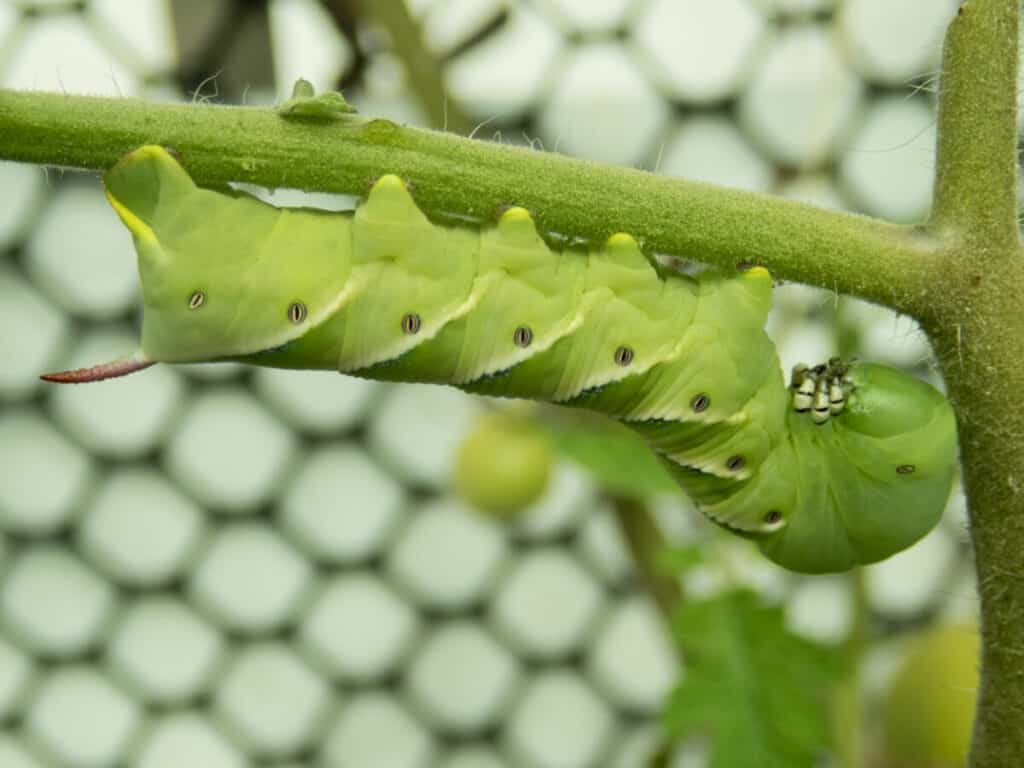Have you ever noticed green, slimy caterpillars crawling around your garden? If so, you may have encountered tomato hornworms.
These pests feed on the leaves and fruits of many garden plants, including tomatoes, peppers, eggplants, potatoes, and more.
In this post, I will provide an overview of tomato hornworms and how to identify them in your garden. I’ll also discuss ways to get rid of them and prevent them from coming back in the future.
So let’s dive in.
What are tomato hornworms?
Tomato hornworms, or Manduca quinquemaculata, are large green caterpillars that can measure up to 4 inches. They have a distinctive white horn on their tails and eight V-shaped stripes along their bodies. These striped markings help them blend in with the foliage of the plants they feed upon.
What damage do tomato hornworms cause on plants?
The tomato hornworm larvae feed voraciously on the leaves, fruits, and stems of the host plant, leaving behind large, ragged holes in their wake.
They may also spread illnesses or diseases, which can further weaken or even kill a plant that is already under attack from these pests. If the infestation is severe enough , it can cause entire crops to be lost.
How to identify tomato hornworms on plants

Tomato hornworms are relatively easy to spot, even if they are blending in with the foliage. Look for their distinctive white tails and V-shaped stripes along their bodies. The damage they cause is
Read more:
How to get rid of tomato hornworms
Hand Pick: One of the easiest and most effective ways to get rid of tomato hornworms is by hand picking them off your plants. Look for them during the day when they are active, as they are often easier to spot then. Be sure to wear gloves while doing this, as their spines can cause skin irritation.
Beneficial Insects: Release beneficial insects such as ladybugs, lacewings, and parasitic wasps into your garden. These insects will feed on the hornworms, keeping their population in check naturally.
Neem Oil: Neem oil is an organic pesticide that can be used to get rid of tomato hornworms on vegetables plants without harming other beneficial insects or wildlife in your area. It works by disrupting the hormones of pests, preventing them from eating or reproducing further.
Read more:
How to prevent tomato hornworms on plants
Crop rotation: Planting different vegetables in different areas of your garden helps reduce the risk of hornworm infestations.
Repellents: Spraying natural insect repellents such as neem oil, garlic spray, or hot pepper spray on your plants can keep hornworms away.
Traps: Sticky traps or light traps can lure and trap adult moths before they lay eggs on your plants.
Handpicking: Monitor your garden regularly for signs of hornworms and pick them off by hand when you find them.
Host vegetable plants for tomato hornworms
Tomato hornworms typically feed on tomatoes, peppers, eggplants, potatoes, and other members of the nightshade family. They may also feed on squash, beans, and other related plants.
Natural predators of tomato hornworms
Some natural predators of tomato hornworms include birds, spiders, toads, praying mantises, ladybugs, and parasitic wasps.
References
- https://extension.umn.edu/yard-and-garden-insects/tomato-hornworms
- https://en.wikipedia.org/wiki/Manduca_quinquemaculata
- https://www.almanac.com/pest/tomato-hornworms

Fact Checked, Written, and Published by Kevin Rodrigues
Kevin is the founder of Gardening Mentor, a website that aims to teach people to grow their own food in a limited space. As a self-taught gardener, Kevin has spent several years growing plants and creating gardening content on the website. He is certified in Home Horticulture and Organic Gardening from Oregon State University. He has a Post Graduate Diploma in Horticulture and Landscape Gardening from Mumbai University.
Read more
